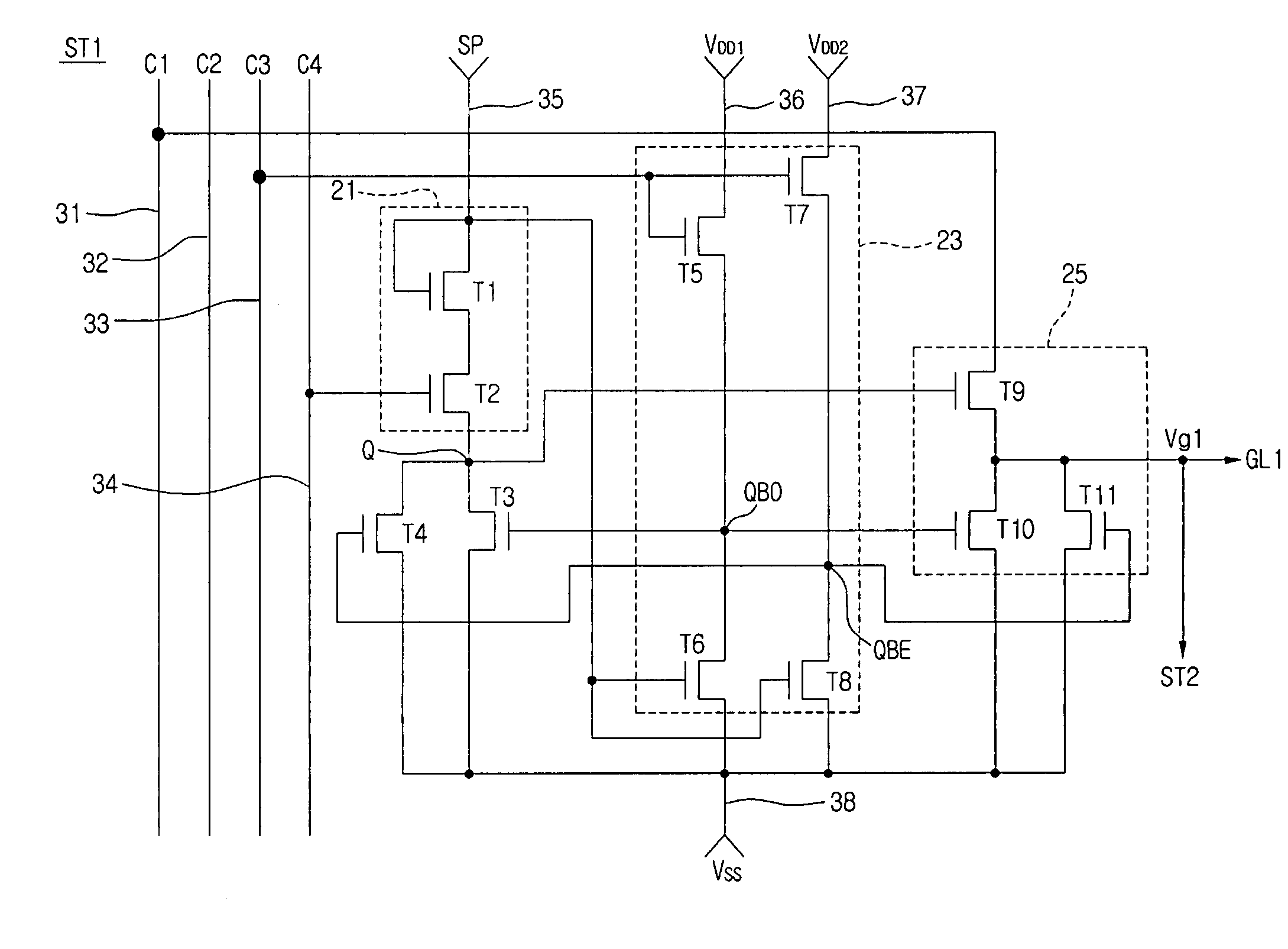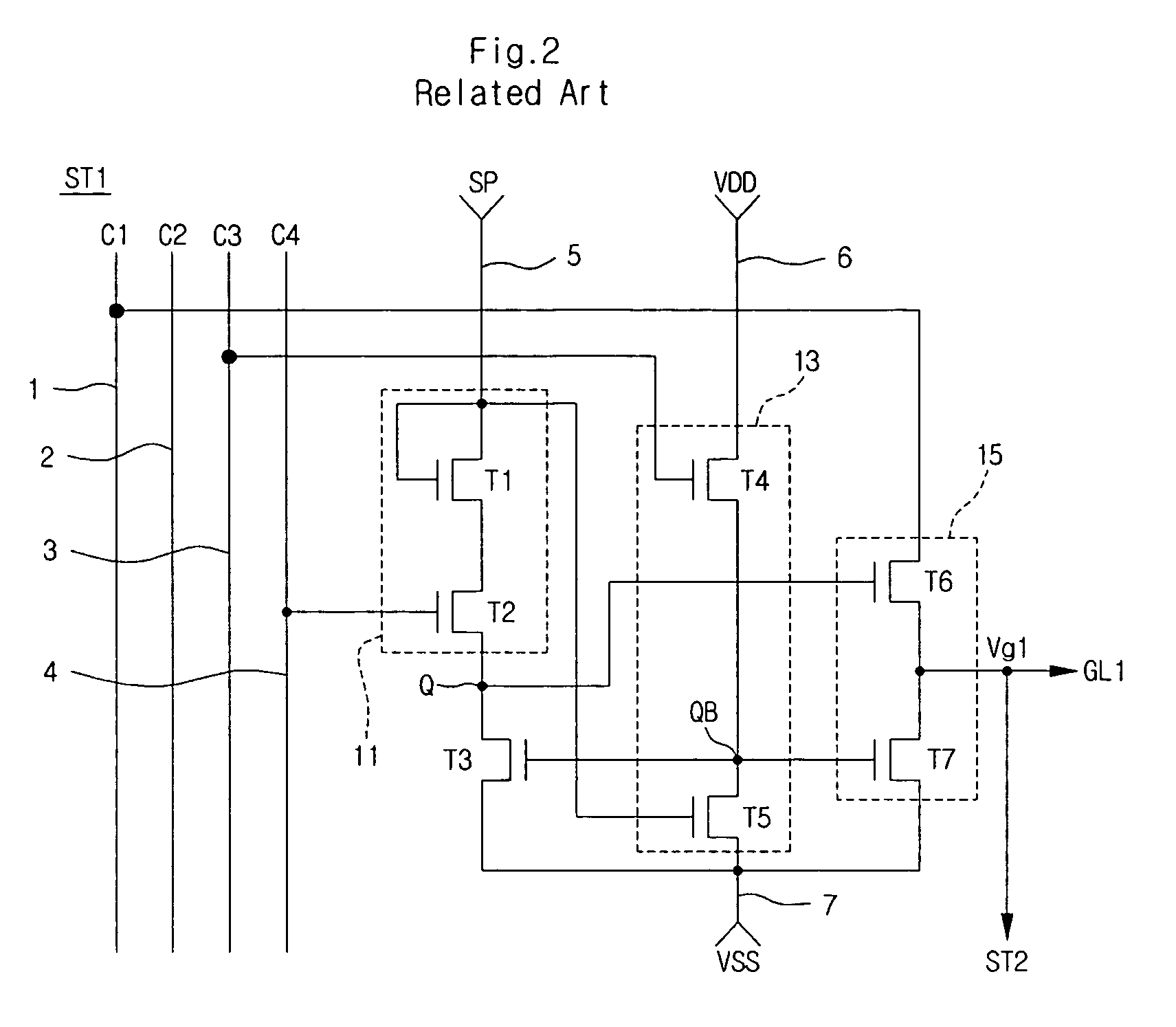Active matrix display device
a display device and active matrix technology, applied in the direction of identification means, digital storage, instruments, etc., can solve the problems of deteriorating device performance, difficult to precisely control the operation of the seventh transistor, and may no longer drive the lcd, so as to prevent the degradation of the shift register, improve the picture quality, and improve the life span
- Summary
- Abstract
- Description
- Claims
- Application Information
AI Technical Summary
Benefits of technology
Problems solved by technology
Method used
Image
Examples
first embodiment
[0045]FIG. 5 is a circuit diagram illustrating a shift register of a gate driver in an LCD according to the present invention. A gate driver of an LCD includes a plurality of shift registers for supplying output signals Vg1 to Vgn in sequence. A description will be made with reference to a first shift register ST1 among the shift registers ST1 to STn. The remaining shifter registers ST2 to STn operate in a somewhat similar manner as the first shifter register ST1. A high-state voltage output signal Vg1 of the first shift register ST1 is supplied as a start pulse to the second shift register ST2, and a high-state voltage output signal Vg2 from the second shift register ST2 is supplied as a start pulse to the third shift register ST3. In the same manner, the remaining shift registers ST4 to STn receive high-state voltage output signals from previous stages as their start pulses and produce high-state voltage output signals whose phases are shifted so as to follow one after another.
[00...
second embodiment
[0077]FIG. 9 is a circuit diagram illustrating a shift register of a gate driver in an LCD according to the present invention. Referring to FIG. 9, a first control part 21 and an output part 25 are similar to those shown in FIG. 5. Only the second control part 23 is different from the second control part of FIG. 5. Therefore, the following description will be made centering on the second control part 23.
[0078] The second control part 23 controls the nodes QBO and QBE to output the first supply voltage VSS through a tenth or eleventh transistor T10 or T11 of the output part 25. The first supply voltage VSS is supplied as the output voltage Vg1 at a low-state voltage through the first gate line GL1. For this purpose, the second control part 23 includes: a fifth transistor T5 coupled to a second supply voltage (VDD1) input line 36, a third clock signal (C3) input line 33, and the node QBO; a sixth transistor T6 coupled to the node QBO, a start pulse (SP) input line 35, and a first supp...
third embodiment
[0090] In this case, the time necessary for the high-state voltage supplied to the node Q to change to the first supply voltage VSS is delayed somewhat due to the characteristic of the node Q. In order to reduce the time delay occurring at the node Q, the third embodiment further includes the fourteenth transistor T14. That is, if the third clock signal C3 becomes a high-state voltage in the fourth period, the fifth and seventh transistors T5 and T7 are turned on at the same time and the fourteenth transistor T14 is also turned on in response to the third clock signal C3.
[0091] Then, the second supply voltage VDD1 at a high-state voltage is supplied to the node QBO due to the turned-on fifth transistor T5, and the third and tenth transistors T3 and T10 are turned on in response to the second supply voltage VDD1 at a high-state voltage at the same time. At this time, the first supply voltage VSS of a low-state voltage is supplied to the node Q due to the third transistor T3. Also, th...
PUM
| Property | Measurement | Unit |
|---|---|---|
| voltage swing | aaaaa | aaaaa |
| voltage | aaaaa | aaaaa |
| voltage | aaaaa | aaaaa |
Abstract
Description
Claims
Application Information
 Login to View More
Login to View More - R&D
- Intellectual Property
- Life Sciences
- Materials
- Tech Scout
- Unparalleled Data Quality
- Higher Quality Content
- 60% Fewer Hallucinations
Browse by: Latest US Patents, China's latest patents, Technical Efficacy Thesaurus, Application Domain, Technology Topic, Popular Technical Reports.
© 2025 PatSnap. All rights reserved.Legal|Privacy policy|Modern Slavery Act Transparency Statement|Sitemap|About US| Contact US: help@patsnap.com



